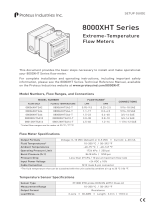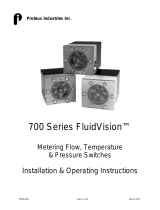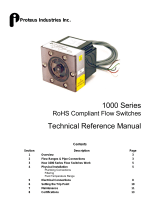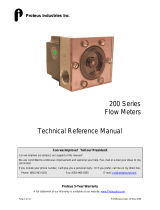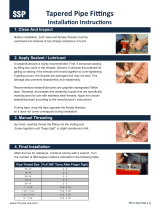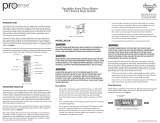Page is loading ...

6000 Series
Pulse Output
Flow Meters
TECHNICAL REFERENCE MANUAL

2
Contents
Section
Description
Page
1
Overview
3
2
Features and Functions
4
3
How the Flow Sensor Works
4
4
Specifications and Performance
5
5
Physical Installation
7
6
Plumbing Connections
8
7
Electrical Connections
11
8
Flow Measurements
12
9
Cleaning and Maintenance
13
10
Characterization and Re-characterization
15

3
Section 1: Overview
Introduction
This document provides comprehensive technical information about the Proteus 6000 Series pulse output
flow meter. Product features, specifications and operating instructions described in this manual are valid
for standard models and may not be applicable to customized versions.
Important Safety Information
NOTE and CAUTION statements are used throughout this manual to highlight important operational and
safety information.
NOTE
NOTE statements provide additional information that is important to the successful
operation of the device.
CAUTION!
CAUTION statements identify conditions or practices that could result in damage to
equipment or other property.
WARNING!
WARNING statements identify conditions or practices that could result in personal injury
or loss of life.
Taking proper precautions to avoid damage to your instrument’s sensors during installation helps to
ensure consistent, error-free operation, which lowers costs and assists on-time completion of your work.
The safety-related statements contained in these instructions provide an alert to installers and operators
to take sensible steps to allow your instrument to operate correctly the first time and every time.
NOTE
It is recommended that the installation of this product be performed by qualified service
personnel only.
Technical Support
For technical or applications assistance, contact:
Proteus Industries Inc.
340 Pioneer Way
Mountain View, CA 94041
Phone: (650) 964-4163
Fax: (650) 965-0304
E-mail: [email protected]
Warranty
Proteus 6000 Series flow meters are manufactured under ISO 9001 certified processes and are
warranted to be free from defects in materials and workmanship for five (5) years from the date of
shipment. The full text of this limited warranty is available on the Proteus Industries website at
www.proteusind.com/warranty.

4
Section 2: Features and Functions
Flow ranges from 0.2 to 227 LPM / 0.06 to 60 GPM
5–24 VDC pulsed PNP and NPN outputs for easy interfacing with your PLC.
The amplitude of the pulse output signal is within 5% of the input voltage.
The output frequency is proportional to flow rate through the meter. At the maximum flow range, the
output frequency is approximately 240 Hz. At the minimum flow rate, the frequency is approximately
10 Hz.
Directly interface to batching, data logging and multi-channel controller accessories.
6000 Series flow meters provide a digital pulse input to compatible programmable process monitors
or controllers for convenient control and reporting flexibility.
The Hall-effect sensor, protected from reverse polarity and over-voltage, provides reliable
outputs in noisy electrical environments.
Stainless steel faceplate extends operating range
Optional stainless steel or brass faceplates enable brass and stainless steel versions of 6000 Series
flow meters to be operated with liquid temperatures from -40° to 110 ºC / -40 to 230 °F and pressures
to 1724 kPa / 250 psi.
Compact Design
6000 Series instrument depths vary with connection size. Outline and 3-dimensional drawings are
available on the Proteus Industries website at www.proteusind.com/6000.
A Viton
®
O-ring provides the liquid seal
Other materials are optionally available for enhanced chemical compatibility with specialized coolants.
Contact Proteus Technical Support for information.
Section 3: How the Flow Sensor Works
The rotor spins when liquid flows through the meter.
Magnets in the rotor switch a Hall-effect sensor mounted in
the meter body.
The resulting pulse train is converted by the electronics to a
voltage that is equal to the supply voltage. The proportional
frequency pulses may be read by your electronics or a
display or intelligent multi-channel monitor supplied by
Proteus.
Metering
Flow characterization curves are traceable to a NIST
reference. Linearity is better than ± 1.5%.
Rotor
Hall Effect Sensor
Magnets

5
Section 4: Specifications and Performance
Flow Ranges, Materials and Connections
MODEL NUMBER
FLOW RANGE*
CONNECTIONS
POLYPROPYLENE
BRASS
STAINLESS STEEL
LPM
GPM
06004PN06
06004BN06
06004SN06
0.23 – 2.3
0.06 – 0.6
1/4" FNPT
06004PN1
06004BN1
06004SN1
0.4 – 5.3
0.1 – 1.4
1/4" FNPT
06004PN2
06004BN2
06004SN2
0.95 – 9.5
0.25 – 2.5
1/4" FNPT
06004SA2
0.95 – 9.5
0.25 – 2.5
9/16-18 SAE
06004PN4
06004BN4
06004SN4
1.1 – 17
0.3 – 4.5
1/4" FNPT
06004SA4
1.1 – 17
0.3 – 4.5
9/16-18 SAE
06006BN9
06006SN9
2.3 – 34
0.6 – 9.0
3/8" FNPT
06006PN10
2.3 – 38
0.6 – 10
3/8" FNPT
06008SA10
3.0 – 38
0.8 – 10
3/4-16 SAE
06008PN14
06008BN14
06008SN14
5.3 – 53
1.4 – 14
1/2" FNPT
06012SA16
4.5 – 61
1.2 – 16
1 1/16-12 SAE
06012BN16
06012SN16
4.5 – 61
1.2 – 16
3/4" FNPT
06012PN19
5.7 – 72
1.5 – 19
3/4" FNPT
06012BN40
06012SN40
11 – 151
3.0 – 40
3/4" FNPT
06016SA40
15 – 151
4.0 – 40
1 5/16-12 SAE
06016BN40
06016SN40
15 – 151
4.0 – 40
1" FNPT
06016PN50
15 – 189
4.0 – 50
1" FNPT
06016BN50
06016SN50
19 – 227
5.0 – 60
1" FNPT
*Listed flow ranges are for water at 20 °C / 68 °F.
CAUTION!
DO NOT exceed the maximum rated flow rate of your 6000 Series flow meter.
Extended operation above the rated maximum flow rate of the instrument will reduce its
usable life.
Temperature & Pressure Operating Limits
FLOW BODY
MATERIAL
FACEPLATE
MATERIAL
TEMPERATURE
LIMIT*
OPERATING
PRESSURE LIMIT
BURST PRESSURE
(5:1)
°C
°F
kPa
psi
kPa
psi
Polypropylene
Clear Polysulfone
70
158
517
75
2586
375
Brass
Clear Polysulfone
100
212
689
100
3447
500
Brass
110
230
1724
250
8618
1250
Stainless Steel
Clear Polysulfone
100
212
689
100
3447
500
Stainless Steel
110
230
1724
250
8618
1250
*This is the fluid temperature that can be sustained with the flow meter cooled by ambient air at 20 °C / 68 °F.
Need to operate above 110 °C / 230 °F? Customized versions of 6000 Series flow meters formed from brass and
stainless steel have been proven in operation with liquid temperatures ranging from -40°C to 170°C / -40 to 338 °F.
For information on extreme-temperature capabilities, please contact Proteus Applications Support at
[email protected] or (650) 964-4163.

6
WARNING!
DO NOT exceed the temperature limit of the flow sensor body or faceplate material.
Operation above the rated temperature can cause failure and create a hazard to operators
and equipment.
WARNING!
DO NOT exceed the pressure limit of the flow sensor body or faceplate material.
Operation above the rated pressure can cause failure and create a hazard to operators
and equipment.
Operating Characteristics
OUTPUT FREQUENCY
~ 240 Hz at maximum flow rate.
PRESSURE DROP
< 69 kPa / 10 psi at the maximum flow rate for all models except
06004PN06, 06004BN06, and 06004SN06.*
INPUT VOLTAGE
5–24 VDC ± 10% with over-voltage and reverse polarity protection
OUTPUT VOLTAGE
Square wave with the same amplitude as the input voltage
OUTPUT SOURCING
Current sinking (NPN) & current sourcing (PNP) outputs
LINEARITY
Better than ±1.5% from 10% to 100% of full scale
REPEATABILITY
Better than ±0.4% above 10% of full scale
CHARACTERIZATION
Typical flow response curves developed for water at 22–25 °C / 72–77 °F
are available for each model. Flow response varies from unit to unit. Unit-
specific characterization conformance reports can be purchased by
specifying part number 0980 when placing your order.
ELECTRICAL CONNECTIONS
4×22 AWG stranded, cabled conductors with FEP insulation and jacket
POWER REQUIREMENT
< 10 mA
STANDARDS AND COMPLIANCE
CE conformity • RoHS and REACH compliance
KINEMATIC VISCOSITY
For use with liquids with kinematic viscosities to 120 centistokes at
operating temperature
*Contact Proteus Application Support for more information.
Other Wetted Materials
COMPONENT
AVAILABLE MATERIALS
STANDARD
OPTIONAL
Rotor
PPS
Kynar
®
O-Ring
Viton
®
Buna-N, Silicone Rubber
Rotor Shaft
316 Stainless Steel
Alumina

7
Section 5: Physical Installation
Sensor Orientation
6000 Series flow meters should only be installed in a horizontal pipeline.
CAUTION!
If the meter is mounted in a vertical pipeline, any leakage from the topmost connection
could enter the unit and cause permanent damage to the electronics.
For the best results, the meter should be mounted with the faceplate in the vertical plane. Mounting the
device with the flow connections uppermost can help eliminate entrained air from your system.
Pipe or Tube Mounting
If rigid piping or tubing is used, a 6000 Series flow meter can be supported by direct connection to the
pipe or tubing.
Panel Mounting
To mount the sensor behind a panel, a minimum of two (2) of the faceplate securing screws will need to
be replaced with longer screws to compensate for the thickness of the panel. Ensure that the screws are
not so long that they will touch the bottom of the tapped hole, or rip through the back of a plastic body if
over-tightened.
CAUTION!
Use washers with a larger diameter than the countersinks in the faceplate in order to
spread the load. Otherwise, cracks can form on the faceplate as a result of the extra
stress on the countersinks.
1. Prepare the mounting panel by evenly spacing up to six (6) holes on a 65.3 mm / 2.5 in. bolt circle for
the #8-32 securing screws circle. Using the two (2) holes on the horizontal plane is usually sufficient
to support smaller sensors with metal bodies and all sensors with plastic bodies.
2. If you wish the rotor to be visible, cut a 43.2 mm / 1.70 in. diameter hole with the same center as the
bolt circle.
3. Remove two (2) or more
screws securing the
faceplate to the sensor
body.
4. Place the sensor behind
the panel and insert the
longer screws through
the panel and into the
sensor body.
5. Secure the screws in
the body with a torque
of approximately 10 in-
lb (finger tight with a
flat-head screwdriver).

8
Section 6: Plumbing Connections
NOTE
It is recommended that connections to brass or stainless steel flow sensors be made with
similar materials to minimize potential corrosion damage.
CAUTION!
DO NOT install metal fittings into units with polypropylene bodies.
The over-tightening of metal fittings in polypropylene bodies can permanently damage
the threads and prevent the creation of leak-free connections.
Minimum Pipe/Connection Inside Diameter
The flow response of a 6000 Series flow meter, and thus its accuracy, may be affected by the inside
diameter (ID) of the incoming pipe as well as any devices attached to the inlet connection and any nearby
upstream devices.
NOTE
The inside diameter (ID) of the inlet pipe or through-hole of a tube connector, hose barb,
or other connecting element must be greater than or equal to the ID of the flow meter.
The table below shows the minimum pipe/connection IDs necessary for standard 6000 Series products. If
the ID of your pipe or fitting is less than the ID of your instrument, the flow response values may not be
correct. Correct flow response characteristics can be developed to allow 6000 Series instruments to be
used with connecting elements with IDs smaller than those shown or to be used with elbows attached
directly to the inlet. For more information, please contact Proteus Applications Support.
MODEL NUMBER
MINIMUM I.D. OF INLET
CONNECTION
MINIMUM STRAIGHT
RUN OF PIPE AT INLET
POLYPROPYLENE
BRASS
STAINLESS STEEL
06004PN06
06004BN06
06004SN06
2.362 mm
0.093 in
23.62 mm
0.93 in
06004PN1
06004BN1
06004SN1
3.175 mm
0.125 in
31.75 mm
1.25 in
06004PN2
06004BN2
06004SN2
4.775 mm
0.188 in
47.75 mm
1.88 in
06004SA2
4.775 mm
0.188 in
47.75 mm
1.88 in
06004PN4
06004BN4
06004SN4
6.858 mm
0.270 in
68.58 mm
2.70 in
06004SA4
6.858 mm
0.270 in
68.58 mm
2.70 in
06006BN9
06006SN9
9.398 mm
0.370 in
93.98 mm
3.70 in
06006PN10
9.398 mm
0.370 in
93.98 mm
3.70 in
06008SA10
10.16 mm
0.400 in
101.6 mm
4.00 in
06008PN14
06008BN14
06008SN14
11.68 mm
0.460 in
116.8 mm
4.60 in
06012SA16
15.49 mm
0.610 in
154.9 mm
6.10 in
06012BN16
06012SN16
15.49 mm
0.610 in
154.9 mm
6.10 in
06012PN19
15.49 mm
0.610 in
154.9 mm
6.10 in
06012BN40
06012SN40
20.32 mm
0.800 in
203.2 mm
8.00 in
06016SA40
22.10 mm
0.870 in
221.0 mm
8.70 in
06016BN40
06016SN40
22.10 mm
0.870 in
221.0 mm
8.70 in
06016PN50
22.10 mm
0.870 in
221.0 mm
8.70 in
06016BN50
06016SN50
25.40 mm
1.000 in
254.0 mm
10.0 in

9
Proximity to Other Devices
The flow response of 6000 Series flow meters may be affected by the form of any devices attached to the
inlet connection as well as any nearby upstream devices. Elbows, T-pieces, valves, or filters located
immediately upstream from the flow meter can introduce a swirling motion to the liquid flow, reducing the
linear velocity of the flow stream. 6000 Series meters are typically unaffected by the form or proximity of
downstream devices.
To ensure optimum performance, a run of straight pipe with a length of at least 10 times the pipe ID
should be present between the meter and any upstream devices. Refer to the table above to identify the
minimum straight-pipe length required for your model.
Flow Direction
6000 Series flow meters with upper flow limits below 7.6 LPM / 2.0 GPM are sensitive to flow direction.
NOTE
For instruments with an upper flow limit below 7.6 LPM / 2.0 GPM (model numbers ending
in N06 or N1), liquid flow should only be introduced into the device through the orifice
labeled “IN” on the right-hand side of the body.
The performance of all other 6000 Series models is not sensitive to flow direction. Liquid flow may be
introduced through either orifice.
Filtering
Your circulating liquid may contain particles. While not essential to the operation of the flow sensor, it is
good practice to filter your liquid. A 100-micron filter is often used to remove rust and other particles from
the liquid. This can increase the usable lifetime of pumps and other fluid system components as well as
reduce wear in the sensor.
Making NPT Pipe Thread Connections
Pipe threads seal by making metal-to-metal or plastic-to-plastic contact between male and female
components. Consequently, they are particularly prone to the damaging effects of galling, which occurs
when two surfaces move against each other under pressure. For this reason, it is essential to use a high-
quality lubricating and sealing material when installing pipe threads. It is recommended that you use a
non-hardening pipe sealant, such as Teflon
®
(PTFE) tape or paste, on pipe threads to create leak-tight
and lubricated junctions at all connection points.
CAUTION!
DO NOT use anaerobic pipe sealants such as Loctite
®
or Swak
®
brand sealants with 6000
Series products fitted with polysulfone faceplates. The aggressive chemical nature of
solvent vapors arising from these materials can cause cracks to develop in the faceplate
materials.
DO NOT over-tighten connections. Refer to installation instructions for the mating fittings for
information on torque requirements.
Leak testing of all connections in your flow circuit is recommended. Pressurizing the system with air
and external testing with a diluted soap solution can help identify leaking connections.

10
Making SAE Straight-Thread Connections
With SAE connections, an O-ring makes the seal while the threads hold the connecting assembly in
place. Straight-thread connections should receive a small amount of high-pressure lubricant before
installation to prevent galling.
Non-adjustable fittings
1. Bring the non-adjustable fitting into firm contact
with the face of the port, using a wrench.
2. Check to be certain that the O-ring fits easily into
the non-threaded receiving area of the port, and
is not pinched.
Adjustable fittings
1. Ensure that the locknut is positioned so the
back-up washer is in contact with the beginning
of the threads farthest from the end of the fitting.
2. Screw the fitting into the port until the back-up
washer contacts the sealing face.
3. Check to be certain that the O-ring fits easily into
the non-threaded receiving area of the port, and
is not pinched or damaged.
4. Unscrew the fitting a maximum of one turn to
position it in the desired direction.
5. Tighten the locknut firmly against the back-up
washer so the fitting assembly is held securely
in place.
NOTE
Air bubbles entrained between the rotor spokes reduce resistance to the rotation of the
rotor and allow the rotor to spin faster. As a result, the instrument will register a higher-
than-actual flow rate until all air bubbles have been eliminated from the flow cavity.
The air bubbles may disperse out of the flow cavity over several hours of operation. The
rate of dispersion is speeded by mounting the instrument with the flow path uppermost.
Pulsing the liquid flow by rapidly increasing and decreasing the flow rate through the
system can also assist by accelerating the bubbles toward the outlet port.

11
Section 7: Electrical Connections
Standard 6000 Series products are fitted with a 4-core cable for connection to the user’s control system.
CAUTION!
The installation of this product should only be performed by personnel familiar with the
electrical circuitry and control functions of the system in which it is to be installed.
CAUTION!
The electronics in a 6000 Series flow meter are sensitive to electrostatic discharge (ESD).
Proper ESD precautions should be taken when handing the instrument’s electronic
components.
1. Locate the 5–24 VDC power source and turn it OFF.
2. Connect the BLACK wire to the negative
(-DC) of the power source.
3. If connecting to an input such as an opto-
isolator or current loop that requires a
current source, connect the input to the
WHITE wire.
For all other applications, connect the
input to the GREEN wire.
4. Connect the RED wire to the positive (+DS) of the power source.
5. Confirm that all wire connections are secure.
6. Turn the DC power source ON.
7. If necessary, adjust the DC voltage to between 5 and 24 VDC.
WIRE COLOR
FUNCTION
Red
Supply voltage (+5–24 VDC)
Black
Supply common (0 VDC)
Green
Current-sinking (NPN) output
White
Current-sourcing (PNP) output

12
Section 8: Flow Measurement
The pulse output of a 6000 Series flow meter is directly proportional to the volumetric flow rate of the
liquid passing through the device. The output is approximately linear and scalable within the meter’s flow
range; however, the flow response curve does not pass through zero.
NOTE
6000 Series flow meters are NOT calibrated devices. There is minor variation in the flow
response from unit to unit.
The table below lists the typical output frequencies at the lower and upper flow limits of standard 6000
Series products.
MODEL NUMBER
LOWER FLOW LIMIT
UPPER FLOW LIMIT
POLYPROPYLENE
BRASS
STAINLESS STEEL
LPM
GPM
Hz
LPM
GPM
Hz
06004PN06
06004BN06
06004SN06
0.23
0.06
8
2.3
0.6
151
06004BN1
06004SN1
0.4
0.1
11
5.3
1.4
155
06004PN1
0.4
0.1
20
5.3
1.4
242
06004BN2
06004SN2
0.95
0.25
15
9.5
2.5
229
06004PN2
0.95
0.25
20
9.5
2.5
240
06004SA2
0.95
0.25
14
9.5
2.5
220
06004BN4
06004SN4
1.1
0.3
11
17
4.5
216
06004PN4
1.1
0.3
20
17
4.5
240
06004SA4
1.1
0.3
11
17
4.5
216
06006BN9
06006SN9
2.3
0.6
11
34
9.0
227
06006PN10
2.3
0.6
20
38
10
240
06008SA10
3.0
0.8
20
38
10
240
06008BN14
06008SN14
5.3
1.4
13
53
14
250
06008PN14
5.3
1.4
20
53
14
240
06012SA16
4.5
1.2
12
61
16
189
06012BN16
06012SN16
4.5
1.2
12
61
16
189
06012PN19
5.7
1.5
20
72
19
240
06012BN40
06012SN40
11
3.0
15
151
40
229
06016SA40
15
4.0
15
151
40
188
06016BN40
06016SN40
15
4.0
15
151
40
188
06016PN50
15
4.0
20
151
50
240
06016BN50
06016SN50
19
5.0
20
227
60
240
NOTE
The flow ranges for each model are valid for water at 20 °C / 68 °F. The use of a different
fluid type and/or temperature can alter the flow response of the sensor.
Specialized flow characterization of the flow response of an individual flow meter is
available for an additional charge. Please contact Proteus Applications Support at
[email protected] or (650) 964-4163 for more information.

13
Section 9: Cleaning and Maintenance
Maintenance of the 6000 Series flow meters is normally limited to cleaning the chamber in which the rotor
spins and annual re-characterization. The frequency of cleaning will vary with the type of fluid being run
and the cleanliness of that fluid. In most cases, annual cleaning immediately prior to re-characertization is
sufficient.
Cleaning a 6000 Series Flow Meter
1. Turn OFF the liquid flow in your flow circuit
and remove the flow meter from your
system.
Place the unit on a clean surface.
2. Remove and retain the six (6) screws
securing the faceplate.
3. Remove the faceplate from the flow meter.
4. Remove the rotor and stainless steel shaft
from the flow cavity.
Remove the O-ring from the faceplate

14
Cleaning a 6000 Series Flow Meter
5. Using a soft cloth dampened with water, alcohol or a light detergent solution, clean debris and dirt
from the rotor, the stainless steel shaft, the inside surfaces of faceplate and the surfaces of the flow
cavity.
6. Inspect the bearing surface of the rotor.
If the bearing surface is worn or not round, replace the rotor.
Inspect the stainless steel shaft.
If the shaft shows signs of scoring or other wear, replace the shaft or the whole faceplate assembly.
7. Inspect the O-ring to ensure that it is not
brittle, cracked or otherwise damaged.
If necessary replace with a #132 O-ring of a
material compatible with the liquid being
passed through the flow meter.
Position the O-ring on the inner rim of the
faceplate.
8. Place the rotor in the flow cavity.
Position the shaft (or the faceplate) to locate
the shaft in the rotor.
9. Position the faceplate so that the holes
in the faceplate are aligned with the screw
holes in the front of the flow sensor body.
Replace the 6 securing screws.
Tighten the screws to a torque of 10 in-lb
(hand tighten with a normal screwdriver).
11. Install the flow meter in your system.
Turn on liquid flow and check for leaks at the faceplate and connecting ports.
Tighten all connections as required to eliminate leaks.

15
Section 10: Characterization and Re-characterization
NOTE
6000 Series flow meters are characterized by Proteus with water temperatures ranging
from 22–28 °C / 72–82 °F.
The use of a different fluid type and/or temperature can alter the flow response of the
sensor, as can the way in which the sensor is connected to your system (as described in
Section 7: Plumbing Connections).
Specialized flow characterization of the flow response of an individual flow meter is
available for an additional charge. Please contact Proteus Applications Support at
[email protected] or (650) 964-4163 for more information.
Checking Flow Meter Response
The frequency at which the flow response curve of a 6000 Series flow meter should be checked is
determined by the accuracy and stability requirements of each application.
Note that no actual calibration adjustments can be made with this flow meter. The response factor or
response curve of the flow meter must be measured, and the new response characteristic or flow
response coefficients must be entered to the controlling processor.
Characterization by Proteus
To obtain a price quotation and a Return Material Authorization (RMA) number for re-characterization of
your flow sensor, contact Proteus Customer Service at sales@proteusind.com or (650) 964-4163.
When received at Proteus, your flow meter will be re-characterized as follows:
1. The output of your meter will be measured and recorded in the as-received state.
2. The rotor, stainless steel shaft and sealing O-ring will be replaced.
3. The flow cavity will be cleaned and the device reassembled.
4. The unit will be re-characterized against reference standards whose calibrations are statistically
controlled against NIST-traceable standards.
5. If characterization is requested, a new characterization certificate will be issued
6. A new characterization label will be attached to the flow meter.
Direct characterization against NIST-traceable standards is optionally available.
Information in this document was correct at the time of printing;
however, specifications are subject to change as Proteus Industries’
continuous improvement processes establish new capabilities.
© Proteus Industries Inc. All rights reserved. All other company and
product names may be trademarks of their respective companies.
6000TRM Rev 002 11/2016
/

